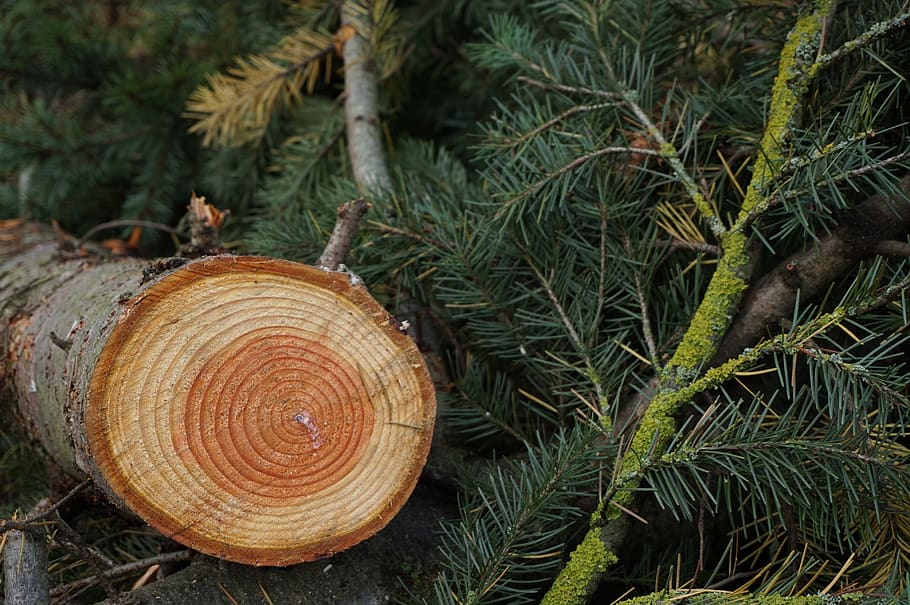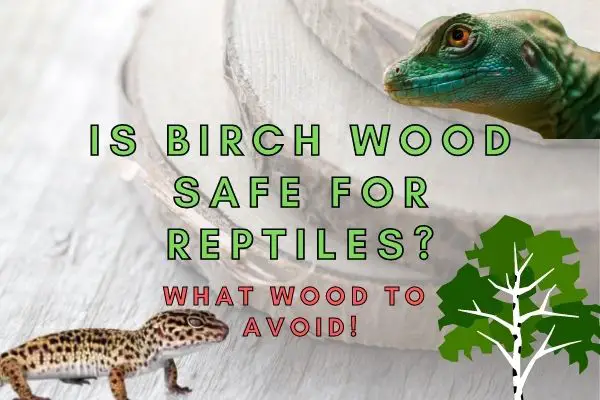Wood can be used for a variety of purposes in terrariums. It can be used as a frame for the glass walls, providing stability and structure. It can also be used to create shelves or other features inside the terrarium.
Birch wood is a good neutral wood type that, in its dry chemical free form, can be used in terrariums and other reptile enclosures.
Wooden pieces can add an extra level of natural beauty to your terrarium design. They can provide contrast and texture, and help to create a more realistic environment for your plants and animals.
When you choose wood for your reptile, safety is of course the most important consideration!
Wood that are safe for reptiles are characterized by having low levels of volatile oils, tannins, slow rates of decay, and strong resistance to rot. Driftwoods, for example, are ideal decorations of humid terrariums because they possess all these qualities. But other wood types such as birch, oak and cherry are good choices as well.
Woods with resins such as pine and cedar wood are not good for reptiles because they contain oils and volatile aromatic phenols which can be harmful to reptiles; including snakes.
Chemicals often applied to processed wood like flame inhibitors and pesticides can also be hazardous to reptiles.
Like I recently wrote about soil safety and rock cleaning in vivariums, I will end this post with a protocol explaining how to make any wood type free of microbes that might harm your reptile!
Contents
Birch wood and reptiles
Birch wood is a type of hardwood that is commonly used in the construction of furniture and cabinets. The wood has a light brown color with a fine grain pattern. Birch is also known for its strength and durability.
Because birch wood does not contain any strong aromatic compounds, toxins and few preservatives are used for its processing, it is mostly safe to use in a reptile tank.
However, be aware that birch wood may absorb humidity easily and thus represent the ideal breeding ground for fungus molds and bacteria!
What wood types are not safe in a reptile enclosure?
Some woods may be totally safe for use in a reptile tank while others could hurt your reptile instantly or over time.
Wood types to avoid in your reptile or amphibian enclosures are:
Cedar wood
Cedar wood is not safe for reptiles because it contains a substance called phenols that can be toxic to them.
In fact, if not properly aged to allow the volatile compounds to evaporate, cedar wood is also bad for humans and other mammals because it can cause respiratory problems, headaches, and skin irritation.
The effect of phenols on reptiles
The effect of phenols on reptiles is still unknown, but it is known that they can have a serious effect on mammals.
For example, phenols are used as solvents and degreasers in industry and household cleaning products because it dissolves fats.

Therefore it can seriously damage the cells in the lungs of reptiles, especially when they live with it in a closed and hot tank!
Is cedar toxic for snakes?
Yes, as a reptile, snakes are quite sensitive to chemicals that can have serious effects on their brain, lungs and eyes.
Snakes are not unlike other reptiles in that they breathe the volatile compounds evaporating from materials. If the wood gives off many phenolic chemicals, the snake will breathe them and may suffer nerve damage or skin irritation resembling an allergy.
Another downside of highly aromatic wood types for snakes is that it disrupts their ability to smell their surroundings properly using their tongue.
Are snakes allergic to cedar?
No, snakes are not allergic to cedar, rather sensitivity to phenols and other chemicals of cedar wood irritate the lungs and reparatory tract of snakes.
This is not unique to snakes and reptiles but rather a universal sensitivity of most animals.
And whereas the reactions to these aromatic compounds may look like allergies, they seldom are.
Reactions are similar to those sometimes seen in sensitive humans such as breathing difficulties, runny nose and eyes and itching red skin.
Pine wood
Pine trees contain resins and oils such as phenols like that of cedar wood, which can cause respiratory problems when they are inhaled.

Pine wood is a common material used in many household items including furniture, cabinets, and floors.
However, some research have shown that the phenols are released during the manufacturing process and do not exist in the final product. Or at least if the wood is of a certain age!
Douglas Fir
The wood of the Douglas fir is strong and durable, making it an excellent material for construction. It is also used in furniture making and paper production.

However, being a coniferous tree, the douglas fir wood does contain resins and volatiles that will be harmful to most reptiles if exposed for prolonged time periods.
Is Fir Bark Safe For Reptiles?
No, the majority of the toxic aromatic compounds found in conifers are found in the bark, so the bark is actually the worst part (after the needles, perhaps!) of the tree to use for reptile and amphibian enclosures.
What other wood types are unsafe for reptiles?
Other wood types of a similar aromatic nature to the ones I just went through that are considered unsafe for reptiles are:
- Juniper
- Yew
- Spruce
- Redwood
- Cypress
- Camphor
- Rosewood
- Hickory
These all have phenolic or similar aromatic compounds that may be irritating to your reptile or amphibian pet. However, if these wood types are allowed to age and dry properly, they can work fine as vivarium decor at a very low risk.
What wood is safest to use for reptiles?
Driftwoods are a good option because they have been drifting above bodies of water for a prolonged period of time and have completely extracted any potentially hazardous chemicals.

Other woods that are regarded as safe for most animals are:
- Ash
- Maple
- Apple wood
- Pear wood
- Cheery wood
- Elm
- Almond wood
- Aspen
- Walnut
Apart from reptile safety, here are some additional things to consider when using wood in your terrarium:
1. The type of wood you use will affect both the look and the function of your terrarium.
2. The size and shape of the wood pieces you use will also impact your design. Large pieces can make a bold statement, while smaller ones can be used to create delicate details or accents.
3. If you’re using live plants in your terrarium, make sure that the wood you select is safe for them too!
How to Make Wood Safe for Reptiles:
If you decide to use natural wood in your reptile enclosure, it is a very good idea to make sure that it contains a minimum of potentially disease causing microbes before you bring it into your vivarium.
One method to make sure the wood is clean enough is outline below:
First, scrub the wood with a rough sponge in warm water. The water will clean the wood and will also remove any dirt that has gone under the surface of the wood.
Next, put the wood into a bleach solution. It should be sufficient to soak the wood in it for 1-2 hours (it might take longer depending on the size and type of the wood).
You can use a solution of 5% bleach to clean the wood after which you rinse in water. The bleach will kill bacteria that are on the surface of the wood. The water rinse will neutralize the bleach, but let it dry completely before bringing it into you terrarium.
As you can see, if you have a lot of wood to do, you can easily make this process much easier by making a large batch of bleach solution and just let it sit in a large container.
If you do not like using bleach, simply soaking the wood in warm water that is 167F (75C) for more than 10 minutes will also do the trick!
And a combination of the two method with the bleach treatment followed by a rinse in hot water will keep you on the safest path towards using wood safety with your reptiles!
The protocols shown here are relevant to wood only and for other materials like soil or rocks, you will have to go by the other means of cleaning described in this post about using soil safety with for reptiles and this post about how to sterilize rocks for vivariums.
Conclusion
If you’re looking for a safe wood for your reptile’s vivarium, there are a few things you need to consider. You should also make sure that the wood you choose will not be toxic to your reptile.
Birch wood, while not the safest options, is pretty much safe if completely dry and not subjected to prolonged humidity and treated with chemicals.
Some types of treated wood may contain chemicals that could harm sensitive plant life. Untreated wood is always the best choice for planting areas, but you need to make sure that the wood is not too “aromatic”, that is, contains natural chemicals that may harm your pet!
With a little creativity, wood can be used to enhance any type of terrarium design and I hope you have a better idea of what wood exactly is safe to use in reptile enclosures!




